- 1New South Wales Department of Primary Industries, Wagga Wagga Agricultural Institute, Wagga Wagga, NSW, Australia
- 2INRA, Agrocampus Ouest, Université de Rennes 1, UMR1349 Institut de Génétique, Environnement et de Protection des Plantes, Le Rheu, France
Soil acidity poses a major threat to productivity of several crops; mainly due to the prevalence of toxic levels of Al3+ and Mn2+. Crop productivity could be harnessed on acid soils via the development of plant varieties tolerant to phytotoxic levels of these cations. In this study, we investigated the extent of natural variation for Mn2+ tolerance among ten parental lines of the Australian and International canola mapping populations. Response to Mn2+ toxicity was measured on the bases of cotyledon chlorosis, shoot biomass, and leaf area in nutrient solution under control (9 μM of MnCl2⋅4H2O) and Mn treatment (125 μM of MnCl2⋅4H2O). Among parental lines, we selected Darmor-bzh and Yudal that showed significant and contrasting variation in Mn2+ tolerance to understand genetic control and identify the quantitative trait loci (QTL) underlying Mn2+ tolerance. We evaluated parental lines and their doubled haploid (DH) progenies (196 lines) derived from an F1 cross, Darmor-bzh/Yudal for Mn2+ tolerance. Mn2+-tolerant genotypes had significantly higher shoot biomass and leaf area compared to Mn2+-sensitive genotypes. A genetic linkage map based on 7,805 DArTseq markers corresponding to 2,094 unique loci was constructed and further utilized for QTL identification. A major locus, BnMn2+.A09 was further mapped with a SNP marker, Bn-A09-p29012402 (LOD score of 34.6) accounting for most of the variation in Mn2+ tolerance on chromosome A09. This is the first report on the genomic localization of a Mn2+ tolerance locus in B. napus. Additionally, an ortholog of A. thaliana encoding for cation efflux facilitator transporter was located within 3,991 bp from significant SNP marker associated with BnMn2+.A09. A suite of genome sequence based markers (DArTseq and Illumina Infinium SNPs) flanking the BnMn2+.A09 locus would provide an invaluable tool for various molecular breeding applications to improve canola production and profitability on Mn2+ toxic soils.
Introduction
Canola (Brassica napus L., 2n = 4× = 38, genome = AnAnCnCn) is the second major oilseed crop grown worldwide, followed by soybean1. It is used as a source of healthy vegetable oil for human consumption, fodder and canola meal for animals, biodiesel for renewable energy and for other pharmaceutical applications (Friedt and Snowdon, 1999). Canola leaves and stems are also used for different culinary preparations such as ‘Saag’ especially in the Indian subcontinent. The increasing demand for canola especially for vegetable oil and biodiesel requires improved strategies to produce higher grain and biomass yield per unit area.
Soil acidity is a major limitation to crop production on 40% of the world’s arable land, caused mainly by the toxic levels of Al3+ and Mn2+ (von Uexküll and Mutert, 1995; Conyers et al., 1997). Of the Earth’s crust, manganese is the second most abundant transition metal after iron, and an essential micronutrient for plant growth (Marschner, 1995). At low pH (≤5), di- and trivalent cations (Mn2+ and Al3+) become solubilized into solution form and inhibit growth of sensitive plants (Pittman, 2005). Extreme environment conditions such as high temperatures in summer, and waterlogging at the end of winter, can also increase the levels of exchangeable Mn2+ in soil and increase the incidence of toxicity (Sparrow and Uren, 1987; Slattery and Ronnfeldt, 1992). Micronutrient deficiency of Fe and Zn can also enhance the uptake of Mn2+ in some plants (Cohen et al., 1998). Al3+ toxicity affects plant growth and yield potential mainly via inhibition of root-tips, whereas Mn2+ toxicity affects plant growth via disrupting photosynthesis due to extensive cotyledon and leaf (margin and interveinal) chlorosis, leaf crinkling/cupping, and leaf and root necrosis in Mn2+-sensitive plants (Heenan and Campbell, 1981; Nable et al., 1988; Moroni et al., 1991, 2003; Kassem et al., 2004). Soil acidity can be ameliorated by increasing the pH with the heavy surface application of lime or dolomite (Scott et al., 1997). However, this approach will not fully alleviate Mn2+ toxicity (Bromfield et al., 1983). In addition, it is very difficult to incorporate lime in the deeper layers of subsoils.
Generally, canola is not recommended for commercial cultivation on strong acidic soils (pHCaCl2 ≤ 4.5). However, crop productivity could be harnessed on acid soils via the development of plant varieties tolerant to phytotoxic levels of Mn2+. Considerable genetic variation, and its physiological and molecular bases for Al3+ tolerance have been revealed in various key agricultural crop plants such as wheat, barley, rice, and sorghum (Moroni et al., 1991; Raman et al., 2002, 2005, 2008; Wang et al., 2007; Ryan et al., 2009, 2010). Several studies have identified qualitative and quantitative loci associated with Al3+ tolerance (Wu et al., 2000; Magalhaes et al., 2007; Cai et al., 2008; Ryan et al., 2009; Krill et al., 2010). In addition, candidate genes involved in Al3+ tolerance have also been isolated and functionally characterized (Delhaize et al., 2004; Raman et al., 2005, 2008; Magalhaes et al., 2007; Ryan et al., 2010). However, information to such extent for Mn2+ tolerance is not yet available for many agricultural crops including canola.
Previous studies have shown that a natural variation for Mn2+ tolerance exists in thale cress (Arabidopsis thaliana L.), soybean (Glycine max L. Merr.), canola and common wheat (Triticum aestivum L.) (Foy, 1984; Hocking et al., 1999; Moroni et al., 2003; Kassem et al., 2004). Wratten and Scott (1979) showed the presence of natural variation for tolerance to Mn2+ toxicity in B. napus and Brassica rapa. In a subsequent study, Moroni et al. (2003) evaluated 39 germplasm accessions and reconfirmed Mn2+ tolerance in B. napus; ‘Mutu (Mutsu),’ ‘Wesreo,’ ‘Tower,’ and ‘91-215-3’ and in one accession of B. rapa; ‘Duro.’ Genetic analysis of the intercross population derived from Mutu-98-6 (Mn2+-tolerant)/RSO94-67 (Mn2+-sensitive) suggests that Mn2+ tolerance is genetically controlled by a single major locus (Moroni et al., 2003; McVittie et al., 2011). However, the locus conferring Mn2+ tolerance has not been mapped yet to the B. napus chromosomes.
This study describes the (i) evaluation of 10 parental lines of different mapping populations, currently being used in the Australian Brassica Germplasm Improvement Program (NBGIP), for Mn2+ tolerance, (ii) construction of a high-density linkage map consisting of 7,805 DArTseq markers corresponding to 2,094 unique bin loci in the Darmor-bzh/Yudal doubled haploid (DYDH) mapping population, (iii) genetic mapping and identification of molecular markers associated with Mn2+ tolerance locus in the DYDH population, (iv) physical localization of the DArTseq sequences linked with Mn2+ tolerance locus and (v) identification of putative candidate gene involved in Mn2+ tolerance in B. napus using A. thaliana orthologs/paralogs implicated in Mn2+ uptake, accumulation and transport on the reference genomic scaffolds of B. napus cv. Darmor-bzh (Chalhoub et al., 2014).
Materials and Methods
Plant Materials
Ten parental lines of DH populations which are currently being used under the Australian Brassica Germplasm Improvement Program (NBGIP); Skipton, Ag-Spectrum, Tapidor, Ningyou, Darmor-bzh, Yudal, Mutu-98-6, RSO94-67, Charlton and Monty (Table 1) were evaluated for Mn2+ tolerance. Besides, this study involved a DYDH mapping population for genetic tagging of Mn2+ tolerance locus. This population was developed previously from an F1 cross between the Darmor-bzh (winter type; maternal parent of French origin) and Yudal (spring type, paternal parent of Korean origin) at the Institut de Génétique, Environnement et de Protection des Plantes, (INRA), France (Foisset et al., 1995). Seed of DH and parental lines was multiplied in caged tents to ensure purity and avoid any cross-pollination, for different phenotyping and genotyping experiments.
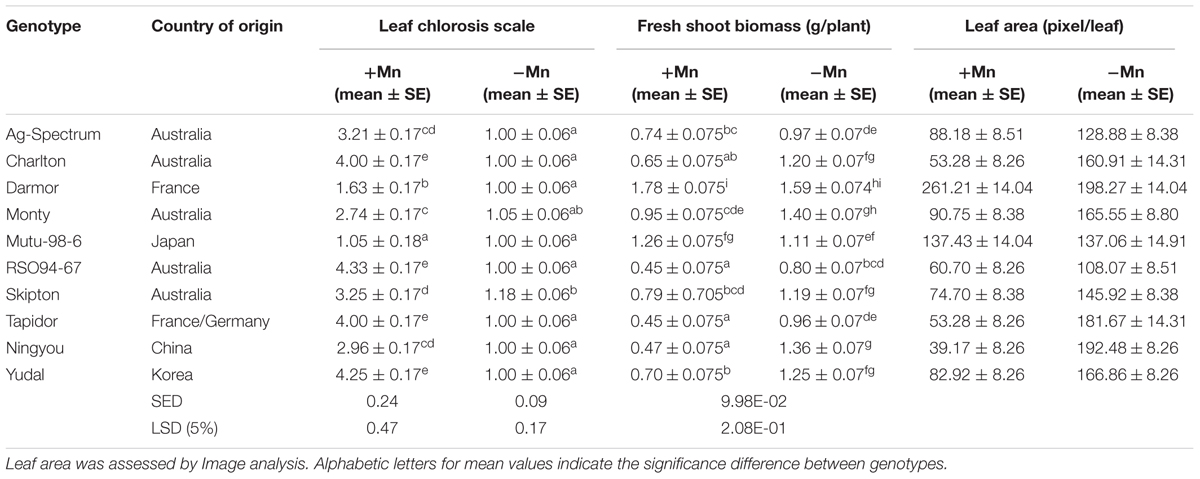
TABLE 1. Mean cotyledon leaf chlorosis, shoot biomass, and leaf area for 10 parental lines of Brassica napus mapping populations in nutrient solution culture under Mn stress (+Mn) and control (-Mn) treatments.
Phenotyping for Mn2+ Tolerance
In order to determine the genetic variation for Mn2+ tolerance, parental lines of mapping populations were either grown in control (+ Mn treatment, 9 μM MnCl2⋅4H2O) nutrient solution or in treatment (++ Mn, 134 μM of MnCl2⋅4H2O) using the nutrient solution culture method as described previously (Raman et al., 2002). A split-plot design of three replicates was followed; with each replicate divided into two main plots (two tubs) to which control (+Mn) or Mn (++ Mn) treatments were randomized. Each tub held a 10 row by 9 range arrangement of cells, with the central range unutilized. Eight seedlings per genotype formed an experimental unit. Treatment experimental units were randomized to blocks of cells arranged as 2 rows by 4 ranges. The experiment was conducted in a temperature controlled plant nutrition laboratory at the New South Wales Department of Primary Industries in Wagga Wagga, Australia (35.0540°S, 147.3485°E), maintained at 20°C ± 2°C.
Two seeds of each B. napus genotype were placed for germination in four arrays of 1.5 mL plastic Eppendorf tubes, pre-filled with the ‘Hobby Fill’ fiber (United Bonded Fabrics Pty. Ltd., Melbourne, VIC, Australia). Trays were placed in a tub as shown in Supplementary Figure S1A. Trays were then over-laid on plastic tubs containing 9 L of the nutrient solution which was continuously circulated and aerated as described previously (Raman et al., 2002). The pH of nutrient solution was adjusted to 4.7 daily with either NaOH (100 mM) or HCl (1.0 N), irrespective of treatment imposed. Seeds in trays were covered with a thick black plastic sheet at 20°C for 48 h in continuous darkness. One seedling of similar vigor was subsequently grown per tube in the nutrient solution. Plants were raised under 16 h (day)/8 h (night) photoperiod regime. Experiments were conducted with a light intensity of 122 μmol photons m-2s-1. After 72 h of Mn treatment, the critical symptoms of Mn2+ toxicity as the extent of chlorosis on cotyledon was scored quantitatively as ‘1’ to ‘5’ on daily-basis for 4 days. All scores taken across different days had a very high correlation (r = 0.8–0.9), therefore the scores of day 4, were used to characterize different genotypes for tolerance to Mn2+ toxicity. A score of ‘1’ indicated a healthy green cotyledon with 0 to ≤10% of cotyledon chlorosis; 2, 3, and 4 scores represented to 10–25%, 25–50%, and 50–75% cotyledon leaf chlorosis, while a score of 5 indicated highly chlorosis covering 75–100% cotyledon area (Supplementary Figures S1B–D). After phenotyping, leaf tissue was collected for genetic analysis.
In order to investigate genetic control for Mn2+ tolerance, 196 lines of the DYDH population and its two parental lines were then evaluated for Mn2+ tolerance using the basal nutrient solution culture method as described previously (Raman et al., 2002). In addition, two DH lines; ‘MUTU-98-6’ and ‘BLN4101-CO0807-10’; generated by NBGIP at Wagga Wagga, were used as Mn2+-tolerant and Mn2+-sensitive controls, respectively. This experiment was conducted in a two replicate randomized complete block design in a temperature controlled laboratory in Wagga Wagga. This experiment had a total of 20 plastic tubs (10 tubs per replicate), each tub accommodating 20 genotypes. The trial consisted of 20 row by 20 column tube arrays with each replication consisting of a 20 row by 10 column tube array. Segregation for Mn2+ tolerance was scored among DYDH lines as described above.
Leaf Area and Biomass Measurements
To determine the relationship between Mn2+ tolerance/sensitivity and shoot biomass, we cut each seedling from the hypocotyl/root junction after 2 weeks of Mn2+ stress and weighed for the fresh shoot biomass from four seedlings of different genotypes (10 parental lines and DYDH lines). We did not measure the root biomass of the seedling as roots were extensively tangled in hydroponic culture and would compromise results (Supplementary Figure S1C). The relationships between Mn2+ tolerance and leaf area were further investigated among 10 parental lines under +Mn and ++Mn treatments. Leaf samples were imaged with the standard office printer/scanner (Canon, MP240). Each sample was spread-out and then scanned. RGB images of leaves were converted to 8 bit grayscale ‘jpeg’ file. Bleached leaf samples were saturated in red scale manually. Entire leaf area was measured using the ImageJ program, version 1.42q2 and expressed in pixels.
To validate the relationship between Mn2+ tolerance/sensitivity and leaf area in the DYDH population, we selected ‘tails’ of DH lines on the basis of the extent of chlorosis. After 14 days of treatment, the first fully expanded leaf from 80 Mn2+-tolerant, and 80 Mn2+-sensitive seedlings per replication was excised; representing the top 20 Mn2+-tolerant (with rating of 1) and the bottom 20 Mn2+-sensitive DH lines (with ratings of 4–5). Leaf samples were taken from selected genotypes plus the parental lines of DYDH population and processed within 4 h. Multivariate analysis based on principal components (principal component analysis, PCA) was carried out to understand overall genotypic variation in response to Mn2+ stress. Since all phenotypic traits: cotyledon leaf chlorosis (%), shoot biomass (g), and leaf area (pixel) measured under Mn2+ stress were on different scales, we standardized the scores; giving equal weight to each variable based on their own mean and variance, and thus correlation matrices were used for PCA.
DNA Isolation and DArTseq Analysis
Frozen leaf samples taken from the fresh leaves of 2- to 3-week-old seedlings from parental lines and their DH progenies were ground into powder using a Mixer Mill 300 (Retsch, Germany). Genomic DNA was isolated following a standard phenol/chloroform extraction method. Genomic libraries were constructed from different samples using 500 ng DNA/μl for DArTseq marker analysis. DH population along with the parental lines were sequenced with an Illumina 2000 sequencing machine to identify the DArTseq markers. The DArTsoft software version 7.4.7 (DArT P/L) was used to score two types of polymorphisms; (i) DArTseq-SNP and (ii) silicoDArTs, also referred to as ‘presence–absence markers’ (2014). DArTseq-SNP markers were scored as ‘1’ for the presence of the reference homozygous SNP allele, ‘0’ for the absence of the reference homozygous SNP allele, “Double null” homozygotes, appearing in the results, due to the absence of a fragment containing the SNP in the genomic representation, were scored as ‘-.’ silicoDArTs were scored in a binary fashion, representing genetically ‘dominant’ markers: ‘1’ for the presence and ‘0’ for the absence of a restriction fragment with the marker sequence in the genomic representation. Markers with only ‘1’ or ‘0’ alleles having frequency of zero were discarded. Only high-quality DArTseq markers with a call rate >80% and with reproducibility >90%, were selected for genetic mapping.
Linkage Map Construction
The genetic linkage map of DYDH population was constructed as described in Raman R. et al. (2016). Linkage map order was checked visually from the graphical representation of recombinant events to ensure the optimal placement of molecular markers. The marker positions were converted to centiMorgans (cM) by applying the Kosambi function (Kosambi, 1944) to the recombination frequencies. The partial linkage map was visualized graphically using the software MapChart (Voorrips, 2002).
Physical Mapping of DArTseq Markers and Candidate Genes on the B. napus Reference Genome
In order to cross-check the genetic positions and chromosomal assignments (A01–A10, C01–C09), marker sequences of the DArTseq were aligned with the published genome assembly of B. napus cv. Darmor-bzh version 4.1 (Chalhoub et al., 2014) as described previously (Raman H. et al., 2016). Physical positions of DArTseq markers were obtained by BLASTN to search for sequence identities between reference genome sequence and the DArTseq markers. Only the top hits were initially considered to be mapped in the genome using a threshold E-10 value. BLASTN matches with multiple hits were only considered when that hit was consistent with the ‘assigned linkage group.’ The orthologs/paralogs of candidate genes involved in Mn2+ transport and accumulation identified in other plant species were also searched against the ‘Darmor-bzh’ reference genome as described above.
Statistical Analyses
Two linear mixed model approaches, REML (Restricted Estimation Maximum Likelihood using ASreml 3.0) and CLMM (Cumulative Link Mixed Models using ‘ordinal’ in R 3.3.2) were used in the analysis of chlorosis scores of 10 parental lines. ASreml 3.0 (Gilmour et al., 2009) was used to fit a linear mixed model which included fixed effects for treatment, genotype and treatment × genotype and random effects for replicate, mainplot, and experimental unit with residual variance modeled separately for each treatment. Appropriate standard errors (SE) and hence least significant difference (LSD) based on degrees of freedom using the methods of Kenward and Roger (1997) were determined using this model. The most conservative 5% LSD was used for testing between treatments. Results from this analysis were compared with results using ‘CLMM.’
Linear mixed models (ASReml 3.0) were also used to model fresh weight and leaf area with the two models similar to the REML model above but excluding unit effects as there was a single measure per experimental unit but including an autocorrelation structure (AR1 × AR1) to model row and range correlation at the residual level. For fresh weight, a single residual variance was estimated but for leaf area residual variance was found to relate to both treatment and genotype. As an alternative to reporting of leaf area pairwise comparisons based on individual pairwise standard errors of difference (SED), we grouped genotypes into two categories based on the residual variance: group I containing genotypes with residual variance of <2,000 pixel, and group II having residual variance > 2,000 pixel, and then predicted values for leaf area were compared based using 5% LSD within and between groups. For both fresh weight and leaf area, a second model with all terms as random effects was fitted to determine heritability values. The broad-sense heritability (hb2) of Mn2+ tolerance was estimated using the equation:
where σg2 is the genetic variance and σe2 is the environmental and residual (error) variance. The estimates of genetic and environmental components were obtained from the ASReml 3.0 package.
Trait-Marker Association Analysis
A dense genetic linkage map of the DYDH population based on 7,805 DArTseq markers corresponding to 2,094 unique loci was utilized for quantitative trait loci (QTL) analysis. Mean cotyledon chlorosis scores were calculated in the ASReml 3.0 package and then used for trait-marker association in the SVS package (Golden Helix, Bozeman, MT, United States). QTL associated with Mn2+ tolerance were identified by the logistic marker regression. Markers having LOD score of ≥4 were initially regarded as significant QTL associations. Furthermore, we applied multiple testing corrections: false discovery rate and Bonferroni adjustment [p < 2.38777E-05 = -log10(p) of 4.622] for the set of 2,094 markers to establish association between markers and Mn2+ tolerance. Manhattan plots revealing trait-marker association on all 19 chromosomes of B. napus were generated in the SVS package. The order of DArTseq markers in relation to Mn2+ tolerance locus (classified phenotypic data) as tolerant (Darmor-bzh type) and sensitive (Yudal type) was rechecked with the RECORD program and presented graphically (Voorrips, 2002; van Os et al., 2006).
Results
Canola Varieties Exhibit Significant Genotypic Variation for Tolerance to Mn2+
Ten genotypes exhibited significant differential response to Mn2+ stress (125 μM) in the nutrient solution, cotyledon margin chlorosis ranged from 1.05–4.33 scale (Tables 1, 2). Among genotypes tested, Mutu-98-6 showed significantly higher tolerance to Mn2+ toxicity, as all cotyledon lobes were normal and had very restricted cotyledonary leaf chlorosis (<10% = 1.05 ± 0.18 scale), whereas Yudal, Tapidor, Charlton, and RSO94-67 displayed the least tolerance to Mn2+ toxicity (4.33 ± 0.17), characterized by extensive chlorosis/bleaching of up to 90% of the cotyledon (Figure 1 and Supplementary Figure S1C). Darmor-bzh also showed high tolerance to Mn2+ (1.63 ± 0.17). Mn2+ toxicity symptoms, measured as chlorosis, appeared initially on the cotyledon leaf margins after 5 days of Mn2+ stress, followed by extensive chlorosis and cupping of cotyledons. Roots were discolored under ++Mn treatment, however we could not clearly establish whether this is actually due to Mn2+ toxicity. Under control treatment, Skipton had significant higher chlorosis than other lines. However, both Skipton and Monty did not differ significantly from each other (Table 1). Based on the differential responses of genotypes to Mn2+ toxicity, we conclude that Mutu-98-6 and Darmor-bzh were unambiguously tolerant as there were no statistical difference [difference/LSD (Mn) = 0.1–1.3] between the control and treatment (Figure 2). We rated the other eight varieties; Skipton, Ag-Spectrum, Tapidor, Ningyou, Yudal, RSO94-67, Charlton and Monty, as Mn2+-sensitive. To confirm whether genotypic variation revealed by the REML analysis is correct, we analyzed the dataset with the ‘Ordinal’ package using ‘clmm.’ Both results from REML and CLMM were in agreement, suggesting that genetic variation identified by the REML analysis indeed exists for Mn2+ tolerance (Supplementary Table S1).

TABLE 2. Restricted maximum likelihood (REML) analysis of per cent leaf chlorosis in 10 parental lines of B. napus mapping populations.
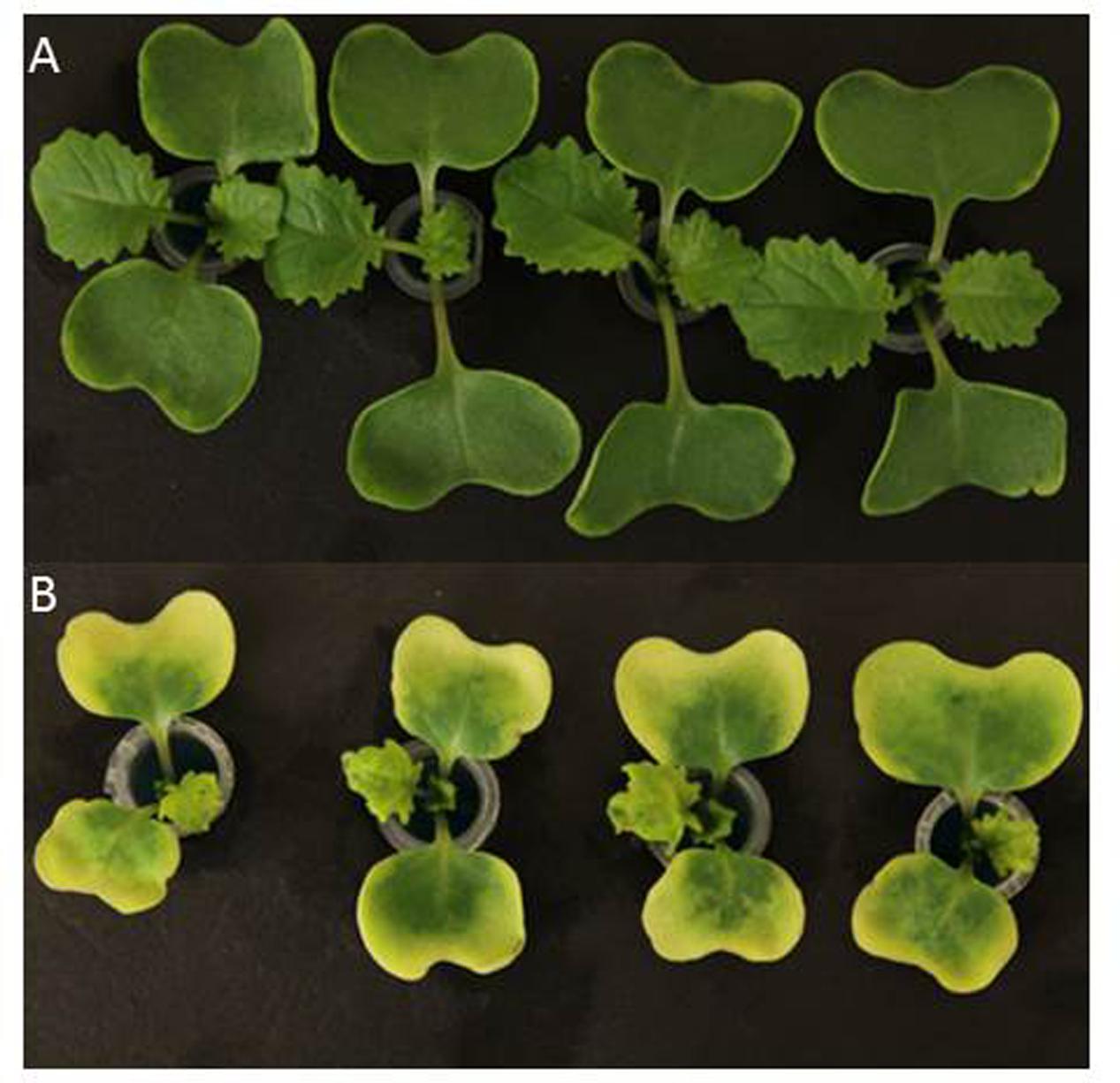
FIGURE 1. Symptoms of Mn2+ toxicity on young canola seedlings (7 days-old) grown in nutrient solution supplemented with MnCl2⋅4H2O (125 μM). (A) Darmor-bzh, and (B) Yudal.
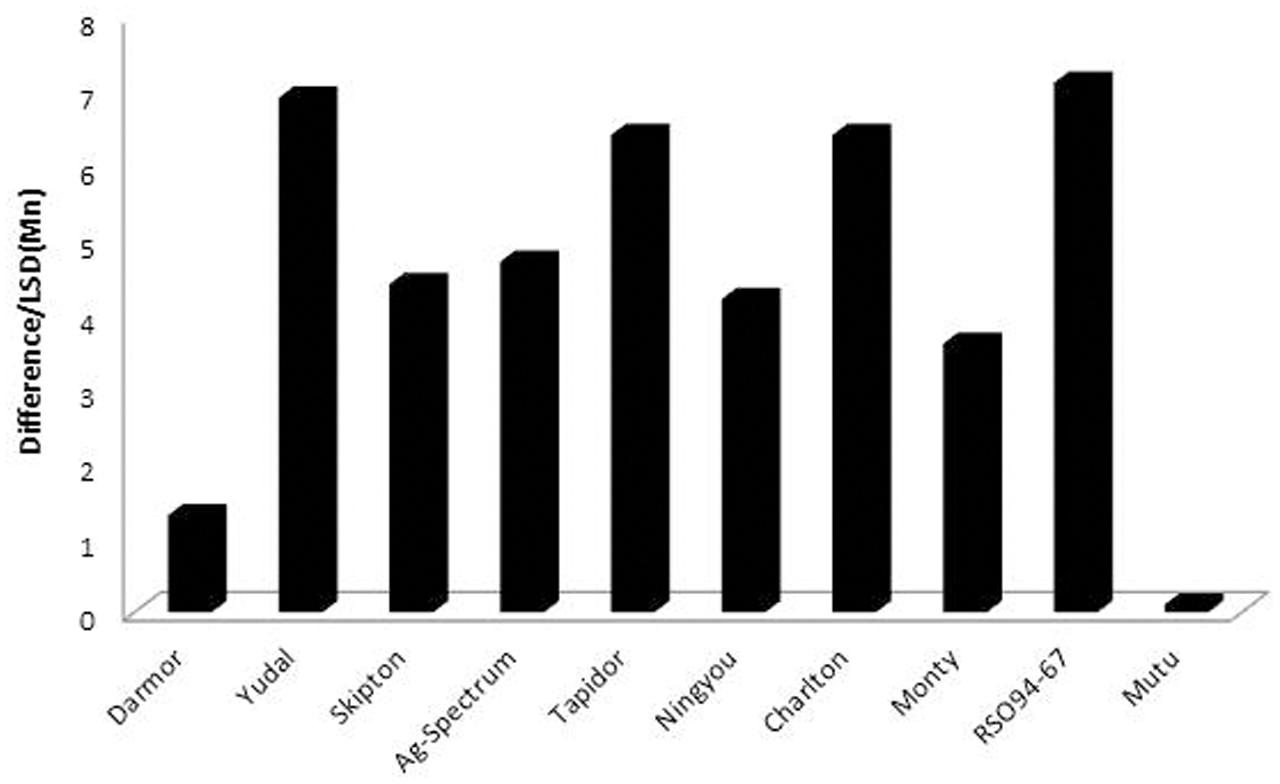
FIGURE 2. Genetic variation for Mn2+ tolerance in B. napus genotypes. Tolerance was compared between control (+Mn, 9 μM MnCl2⋅4H2O) and treatment (++Mn, 125 μM MnCl2⋅4H2O). The extent of leaf chlorosis was estimated as difference [+Mn mean – control Mn mean/LSD (Mn)].
After scoring for Mn2+ tolerance at the cotyledon stage, plants were raised further for 2 weeks. In addition to symptoms on the true leaves, the effect of Mn2+ stress on plant (shoot) biomass and leaf area (of first fully expanded leaf) was also measured. REML analysis showed that variation in shoot biomass and leaf area, is genetically determined (Supplementary Table S2). Consistent with previous observations (Wratten and Scott, 1979; Moroni et al., 2003), necrotic spots, interveinal and marginal chlorosis and crinkling of true leaves eventually leading to dark brown necrotic lesions was clearly evident, (Supplementary Figure S2). All Mn2+ sensitive genotypes had significantly lower fresh shoot biomass. However, there was no significant decrease in shoot weights and leaf area between ‘control’ and ‘treatment’ in Mn2+ tolerant genotypes, Darmor-bzh and Mutu-98-6 (Table 1), suggesting that Mn2+ stress adversely affects plant growth possibly via reducing photosynthetic active leaf area in Mn2+ sensitive genotypes. Leaves of several Mn2+ sensitive genotypes RSO94-67, Tapidor and Ningyou were highly bleached. Similarly, Mn2+ tolerant genotype, Darmor-bzh had significantly higher leaf area than other genotypes, irrespective of Mn treatments (5% LSD). Of all genotypes tested, Mutu98-6 had higher leaf area compared to other genotypes and remained unaffected by ++Mn treatment (Table 1). The repeatability (hb2) values for leaf chlorosis were higher (90%) compared to shoot biomass and leaf area (65%). Pearson’s correlation coefficient (r) was calculated among pairs of test traits, leaf chlorosis was negatively correlated with shoot biomass (r = -0.82) and leaf area (r = -0.71). Consistent with REML analysis, significant variation in response of genotypes to Mn2+ stress was detected with PCA. The normalized REML means for genotypes under Mn2+ stress revealed that the first principal component (PC1) account for 88.8 % of the variance (Table 3), suggesting that phenotypic variation in response to Mn2+ stress was due to major effect of genetic tolerance. The PC2 and PC3 accounted only for 10.5%, and 0.7% of phenotypic variance, respectively. All components; chlorosis, leaf area and shoot biomass contributed equally to PC1 based genotypic variation. Based on these components, all 10 genotypes were assigned to two clusters (I and II). First cluster included Darmor-bzh and Mutu genotypes, whereas cluster II consisted rest of the eight genotypes, representing Mn2+ tolerant and Mn2+ sensitive phenotypes, respectively (Figure 3).
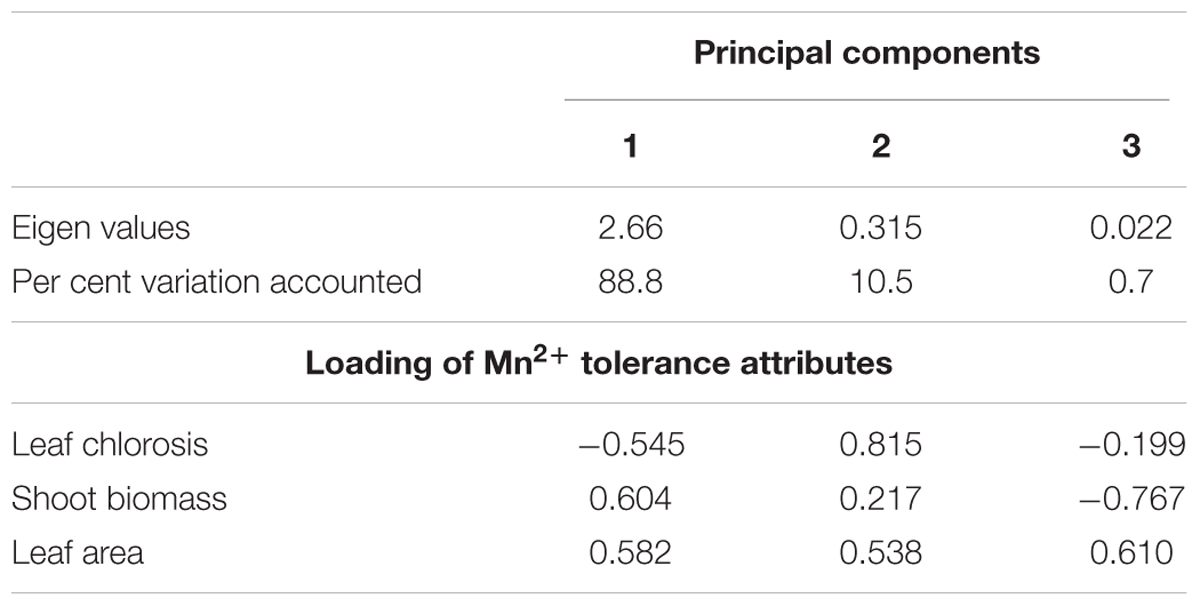
TABLE 3. Principal component analysis of normalized means for the extent of leaf chlorosis, shoot biomass and leaf area among 10 parental lines of doubled haploid populations of B. napus grown in nutrient solution supplemented with 125 μM of MnCl2 4H2O.
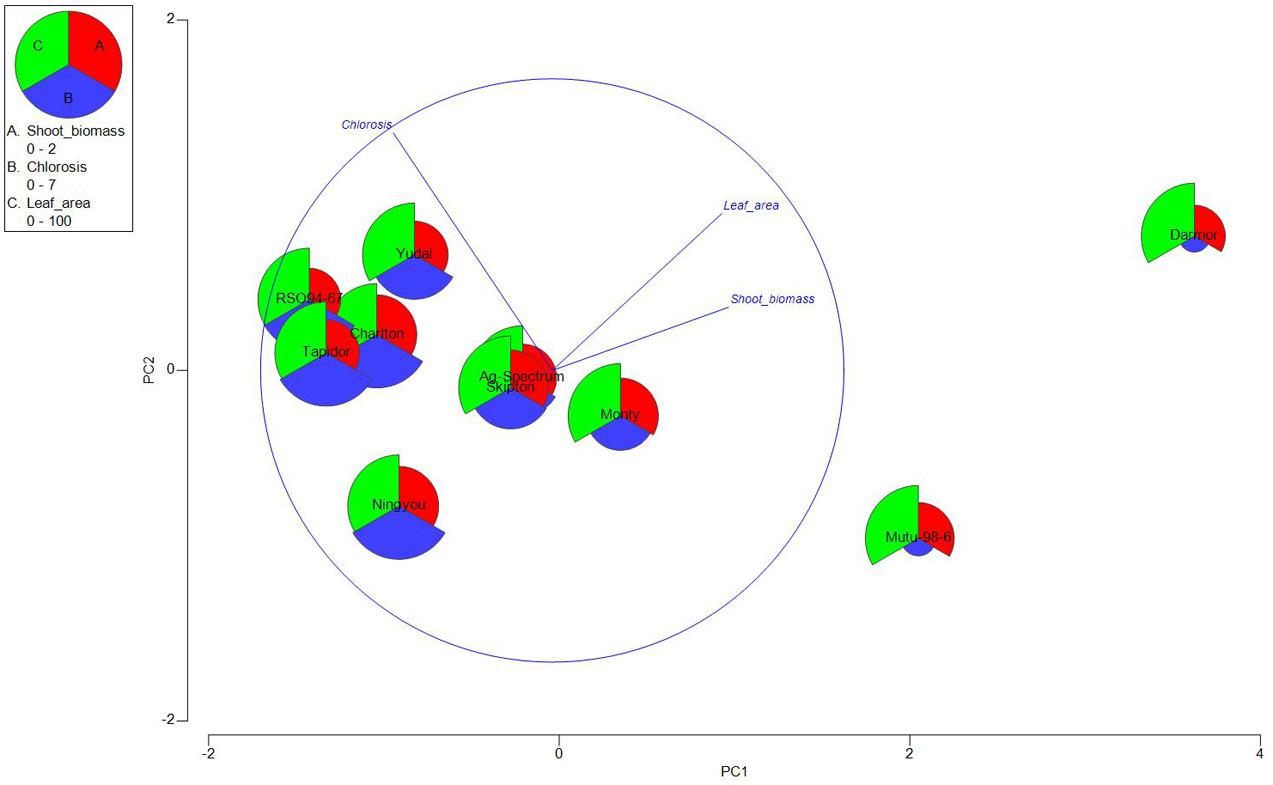
FIGURE 3. Principal Component Analysis (PCA) of the ten parental lines evaluated for Mn2+ tolerance. Genetic variation in Mn2+ tolerance was scored on the bases of cotyledon leaf chlorosis, shoot biomass and leaf area. The first two principal components; PC1 and PC2 represent the X-and Y-axes, accounting for 88.8% and 10.7% of the phenotypic variance, respectively. REML means were normalize using correlation matrices among different component traits: leaf chlorosis, shoot biomass, and leaf area (measured from the second fully expanded leaf).
A Single Gene Controls Natural Variation for Tolerance to Mn2+ Toxicity
The genetic control of Mn2+ tolerance was investigated in the DYDH population. Both parental lines of DYDH population showed significant differences for Mn2+ tolerance; the extent of leaf chlorosis on Darmor-bzh was ∼2.5× lower than that on Mn2+-sensitive parent, Yudal (Table 1). Phenotypic scores on cotyledon showed the typical skewed normal distribution, suggesting that presumably major qualitative loci controls Mn2+ tolerance in this population (Figure 4). Some of the DH lines also showed transgressive segregation for Mn2+ tolerance. The analysis of variance revealed that the phenotypic variation on Mn2+ tolerance is driven mainly due to ‘genotype’ (Table 4). The h2b for Mn2+ tolerance in the DYDH population was 65%. These results implied that Mn2+ tolerance is a heritable trait in the DY population and, therefore genetic improvement can be made efficiently in the breeding programs.
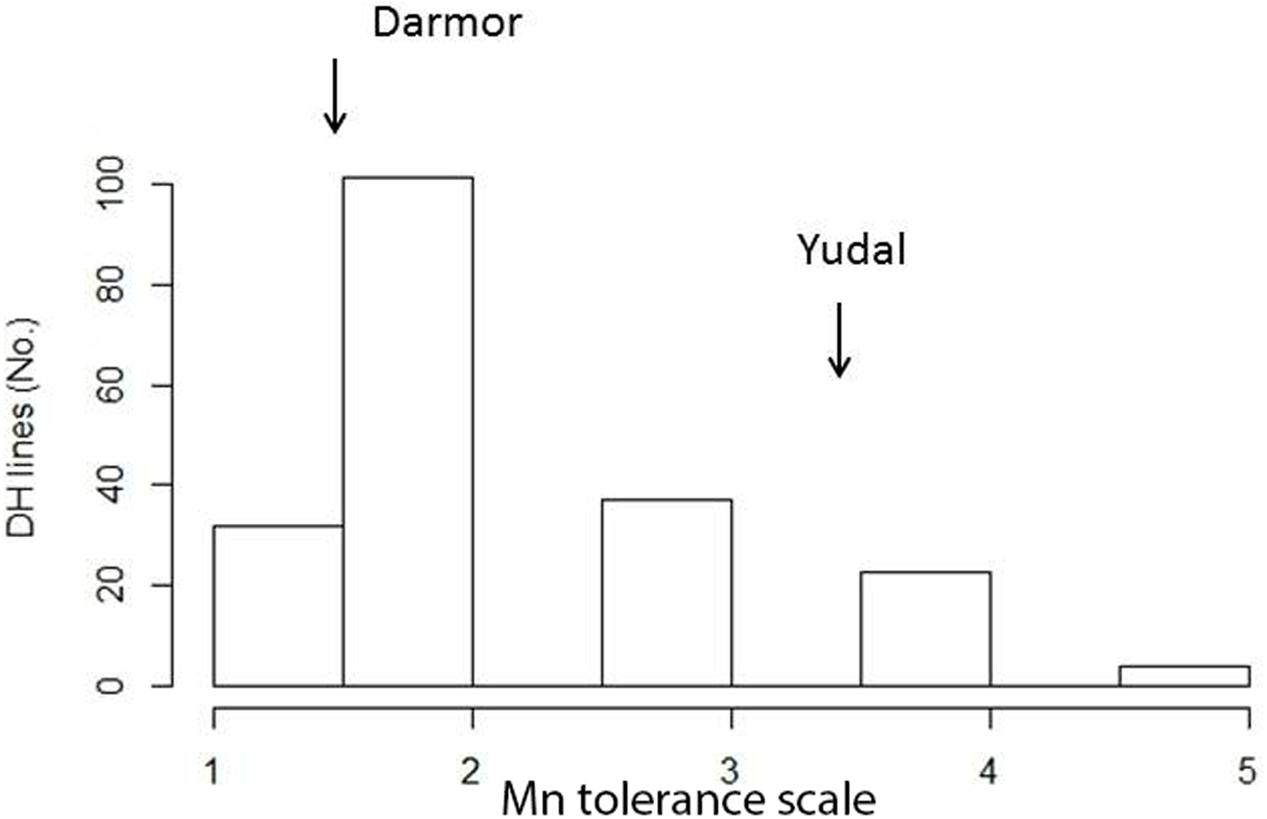
FIGURE 4. Frequency distribution of Mn2+ tolerance scores in the doubled haploid mapping population derived from an F1 cross between Darmor-bzh and Yudal (DYDH). The phenotypic scores based on the extent of chlorosis of parental lines, Darmor-bzh and Yudal are marked with inverted arrows.

TABLE 4. ANOVA analysis of Mn2+ tolerance, measured as leaf chlorosis in a doubled haploid population from Darmor/Yudal.
Major Locus for Mn Tolerance, BnMn2+.A09 Is Localized on Chromosome A09 of the B. napus cv. Darmor-bzh
We constructed a genetic linkage map based on DArTseq markers of the DYDH population (Table 5). A total of 7,805 markers, comprising 5,464 in silico DArTseq and 2,341 DArTSeq-SNPs, were integrated in the linkage map representing all 19 chromosomes of the An, and Cn subgenomes representing a haploid chromosome number of B. napus (Supplementary Table S3). Several markers showed distorted segregation ratio, deviating from the monogenic ratio in a DYDH population [overall χ2(1:1) = 171.852, P(0.05) < 0.0001], consistent with the previous observation (Wang et al., 2011). The length of the linkage groups ranged from 70.94 (A04) to 196.41 (C03) cM. The linkage groups A08, A10, and C07 were shorter compared to others. Of the 19 linkage groups, C03 had the maximum marker density (179), while C09 had the least (64). An subgenome had the higher number of discrete markers (1,213) compared to the Cn subgenome (881). These markers were mapped in 2,094 unique marker bins; covering a total of 2,228.82 cM (Supplementary Table S4) and with an average map density of 0.94 markers per cM (Table 5). This genetic linkage map was used further for identification of QTL associated with Mn2+ tolerance.
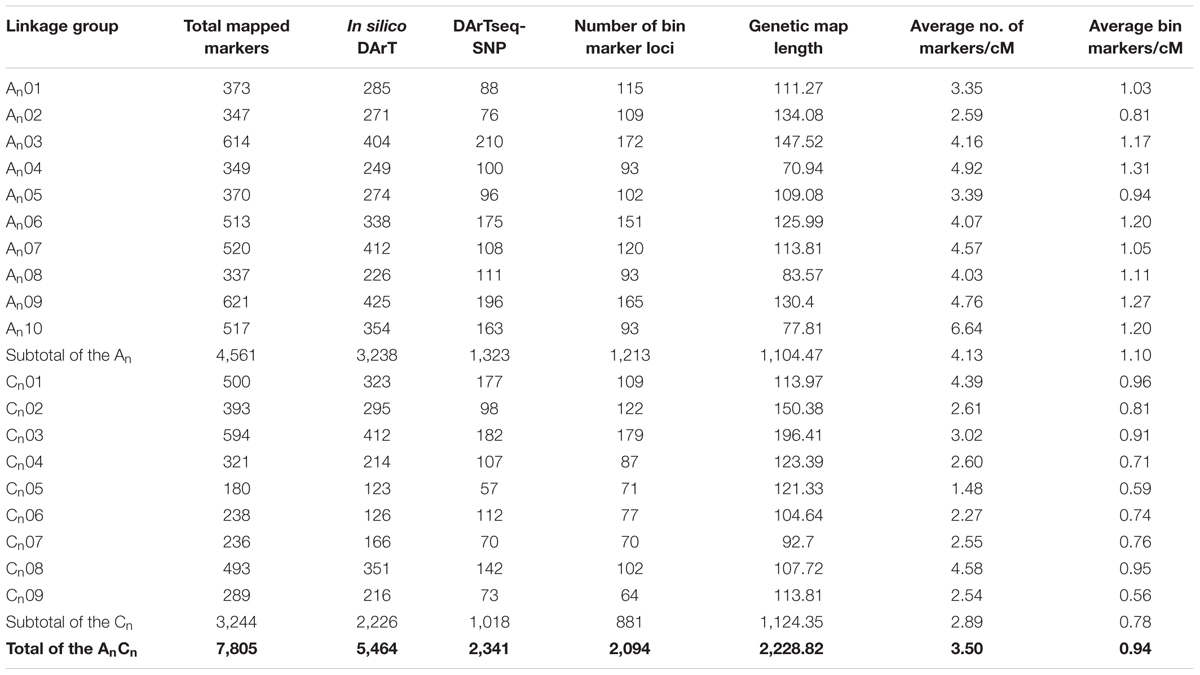
TABLE 5. Summary of markers, and their distribution and density across different linkage groups and subgenomes (An and Cn) of the Darmor/Yudal DH population of B. napus.
Logistic marker regression analysis revealed 93 markers that showed statistically significant associations (LOD score ≥ 4) with Mn2+ tolerance scored on the basis of leaf chlorosis (Supplementary Table S5). Of them, 58 markers were localized on linkage group A09 whereas 24 were mapped on its homologous group C08 (Figure 5A). The top two markers, 3151996 (in silico DArT) and 3103599_60:A > G (DArTSeq SNP) showed the highly significant association with -log10(p) score of ≥32.5, suggesting that these markers underlie the genomic region: BnMn2+.A09, for phenotypic variation in Mn2+ tolerance on chromosome A09. To validate the association between BnMn2+.A09 and DArTseq markers, we targeted 100 kb region of the BnMn2+.A09 flanking coordinates 26,812,076–27,047,795 bp, and identified 30 polymorphic Illumina Infinium 60K SNP markers in the DYDH population based of their physical location on the An09 Darmor-bzh genome sequence (Clarke et al., 2016). Those polymorphic SNP markers were further tested for their association with phenotypic data (chlorosis scores). Of 30 Illumina SNP markers, Bn-A09-p29012402 located on unassembled portion of the Darmor-bzh sequence of chromosome A09-random showed the maximum association (LOD = 34.6) with Mn2+ tolerance in the DYDH population (Supplementary Table S6). Eight Illumina SNP markers, which showed the complete linkage with each other (delimited with Bn-A09-p28914189 and Bn-A09-p29087590 markers) also showed highly significant association (LOD = 34.2) with Mn2+ tolerance (Figure 5B). This marker locus was located within 3.2 kb from the significant DArTseq markers linked with BnMn2+.A09 (Supplementary Table S4). To confirm the trait-marker association results obtained with the SVS package (Supplementary Table S5), we performed interval mapping using R/qtl package (Broman et al., 2003). Two genomic regions: QMn2+.wwai-A09 (LOD = 32.71) on chromosome A09 and QMn2+.wwai-C08 (LOD = 4.01) exhibited significant associations with Mn2+ tolerance in a DYDH population. QMn2+.wwai-A09, flanked by BnA09-p28910059 and 3151996 markers accounted for 41.5% of the variation for Mn2+ tolerance, while QMn2+.wwai-C08, flanked by 5030207_47:T>A and 3111010_34:A>C accounted for 3.9% of the variation. Both QTL were mapped within the same genomic regions that showed significantly associations for Mn tolerance identified with logistic regression approach in the SVS package. At both QTL, the Darmor alleles contributed toward Mn2+ tolerance. Both QTL on chromosomes A09 and C08 did not show any significant interaction.
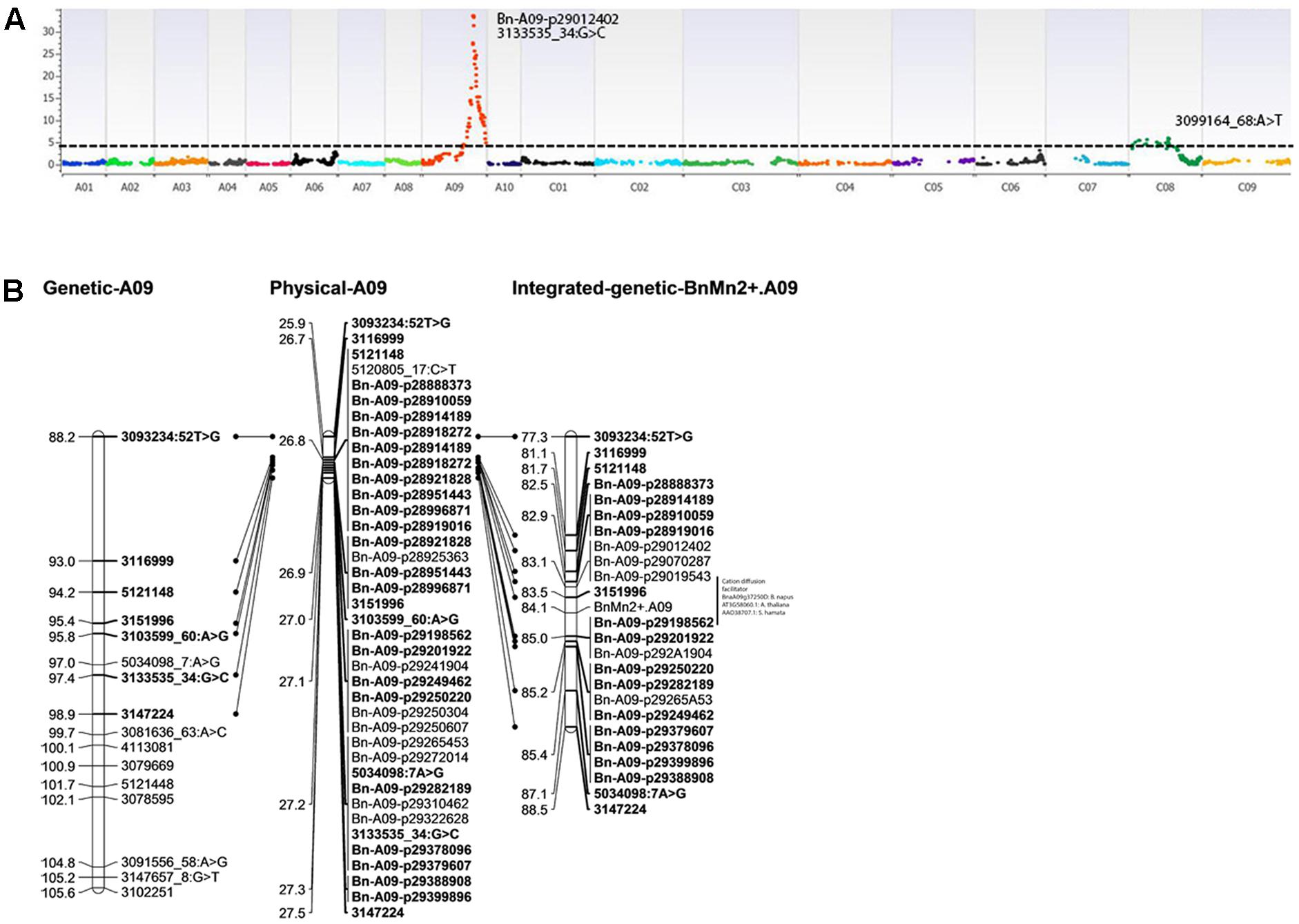
FIGURE 5. (A) Manhattan plots of association between DArTseq markers and Mn2+ tolerance scored as per cent leaf chlorosis in the DYDH population. A linkage map based on 2,094 bin-marker loci was used for trait-marker association. The horizontal dotted line represents the Bonferroni-corrected significance threshold of –log10(p) of 4.6220. Black arrow on the SNP associations indicates the peak signal; (B) Map location of a major QTL associated with Mn2+ tolerance; QMn2+.wwai-A09 in canola on chromosome A09 in the DYDH population. Localization of DArTseq markers on both genetic and physical map of B. napus cv. Darmor-bzh (Chalhoub et al., 2014) is shown with dotted lines. Graphical representation was drawn with Record Program. Genetic distances (cM) are shown along the partial linkage map on the left side and molecular markers are shown on the right side. Vertical lined represents the position of QTL. Candidate genes located between the QTL marker intervals are also shown.
To precisely map this genomic region as a Mendelian locus, we classified DH lines as ‘Darmor-bzh’ or ‘Yudal’ type allele based on the phenotypic scores (extent of percent chlorosis): 1–2 as Mn2+-tolerant, and 2.1–5 as Mn2+-sensitive. Among the DYDH lines, 104 were rated as Mn2+-tolerant and 71 were rated as Mn2+-sensitive. These segregation ratio showed significant deviation from expected between observed and expected values for a single major locus (χ2 = 6.223, P = 0.0126). Linkage analysis between phenotype (binary phenotypic data: tolerant/sensitive) and genotypic data (DArTseq and Illumina SNP marker alleles) showed that the two sequence-based markers; 3151996 and BnA09-p29201922 flank the Mn2+-tolerance locus in the DYDH population in the order of 3151996 – BnMn2+.A09 – BnA09-p29201922 (Figure 5B).
In order to verify whether the Mn2+ stress affect plant growth in the DYDH lines, we measured the shoot biomass and leaf area of 160 individuals of 40 DH lines; representing 20 each extreme tolerant and sensitive DH lines under Mn2+ stress. Our results revealed that Mn2+ tolerant genotypes had higher fresh shoot biomass compared to sensitive genotype and showed significantly higher correlation (r = 0.7). Similarly, a positive correlation (r = 0.89) was found between the level of Mn2+ tolerance and leaf area among extreme 40 DH lines. Leaf area ranged from 20.4 K pixels (DY081 DH line) to 193.63 K pixels (DY053 DH line); it was higher in tolerant lines than sensitive lines (Figure 6). Parental lines; Darmor-bzh and Yudal showed the similar trends for both shoot biomass and leaf area.
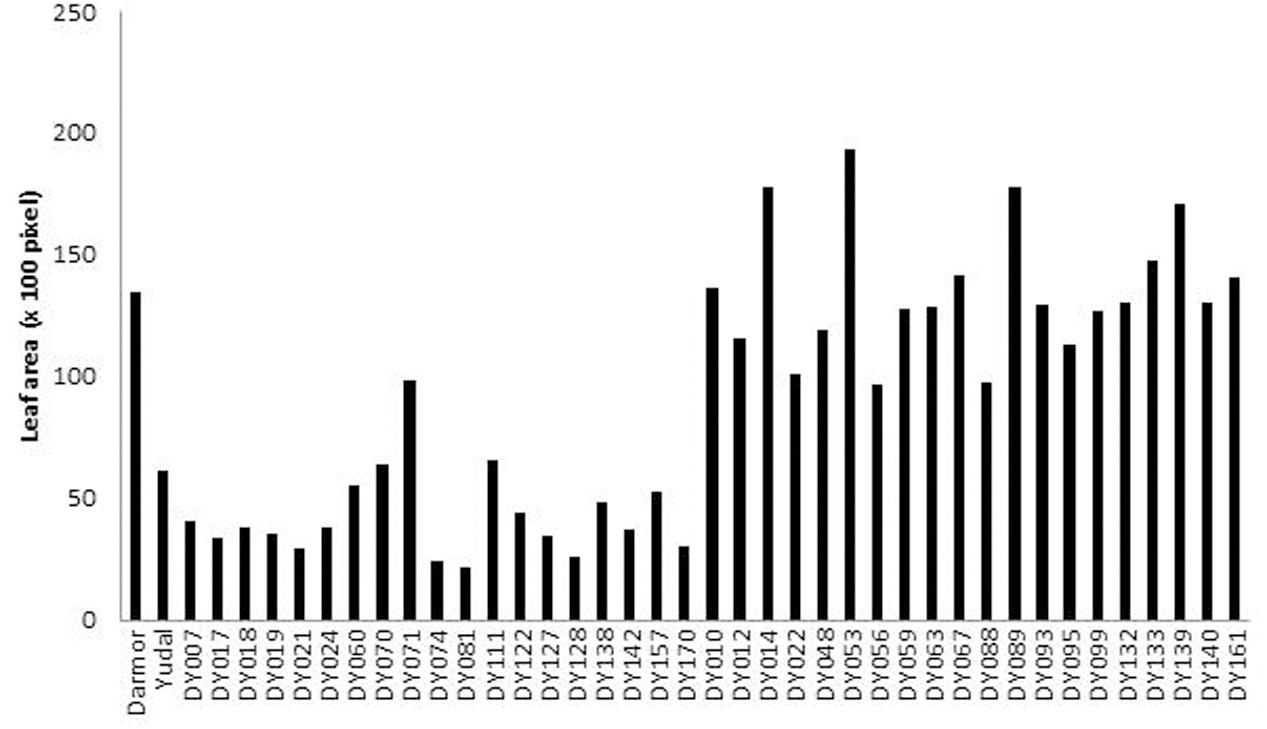
FIGURE 6. Leaf area of Darmor-bzh (tolerant) and Yudal (sensitive) and its 20 extreme Mn2+ tolerant and 20 extreme Mn2+ sensitive DH progenies of Darmor-bzh/Yudal DH population grown in modified nutrient solution supplemented with MnCl2⋅4H20 (125 μm). Leaf area was measured with ImageJ software and expressed in pixel.
Physical Mapping of Significant Marker Loci Linked with BnMn2+.A09 Locus
We searched the sequence identities including of all 93 markers that showed statistically significant associations with Mn2+ tolerance with the reference genome scaffolds of Darmor-bzh assembly. Approximately 61% of DArTseq markers (4,741/7,805) could be anchored on the expected pseudomolecules (top hits). Of them (93), 58 markers were localized on the A09 genome scaffold, whereas 24 were mapped on its homologous scaffold; C08 (Supplementary Table S4). Collinearity was observed between the order of markers within the A09 linkage group and the corresponding An09 pseudomolecule of B. napus cv. Darmor-bzh/B. rapa cv. Chiifu, assemblies (Figure 7). We could not determine the precise localization of other 11 markers on the Darmor-bzh genome assembly (Supplementary Table S4). The highly significant marker; 3151996 (LOD = 32.9) associated with Mn2+ tolerance was localized at the physical position, 26,926,623 bp of Darmor-bzh sequence within 5 kb of the reference scaffold v4_181 on chromosome An09, and this genomic region is tagged with the scaffold v4_181_291620_BS008304 SNPFSRSO marker (Chalhoub et al., 2014; see Supplementary Table S9).
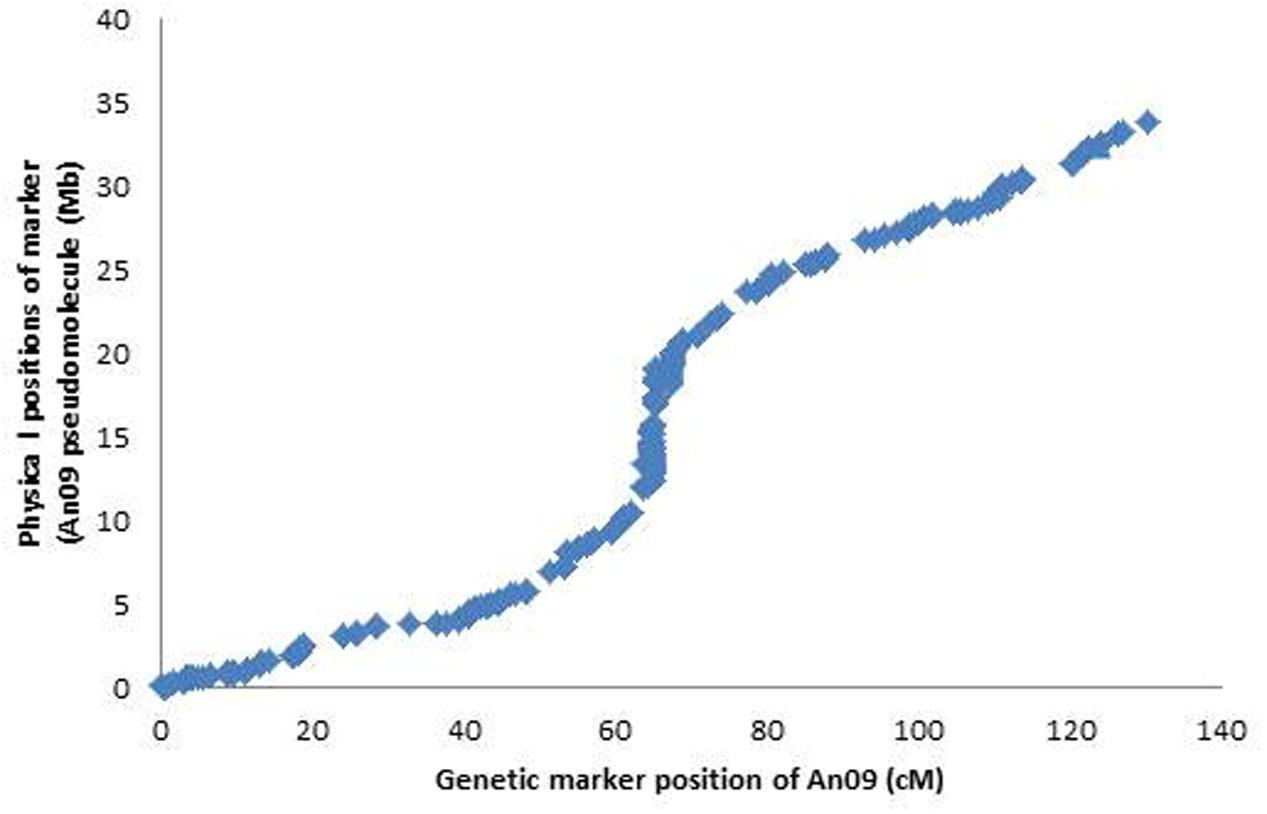
FIGURE 7. Graphical plot of genetic distance (Y-axis, in cM from the linkage map of DYDH population) and physical distance (X-axis, in Mb from the genome assembly of Darmor v4.1) for the A09 chromosome of B. napus is shown.
Localization of the Putative Candidate Genes Involved in Mn2+ Tolerance
To identify candidate genes for Mn2+ tolerance between flanking the significant SNP marker intervals flanking the BnMn2+.A09 locus, we searched for sequence identities of genes involved directly or indirectly in Mn2+ transport and accumulation in yeast, insects, birds, mammals, and plants, such as natural resistance-associated macrophage protein transporters (AtNramp1, AtNramp2, AtNramp3, and AtNramp4); divalent metal transporters; phosphate transporter 1; ZIP (Zn-regulator transporter/iron-regulated transporter (ZRT/IRT1); endoplasmic reticulum Ca2+- and Mn2+ transporting P-type ATPase; tonoplast-localized cation/H+ antiporter; the cation exchanger, AtCAX2; metal transporter protein 1; vacuolar-localized cation diffusion facilitator/cation efflux family (ATMTP11, shMTP1-4, ATMTP8, shMTP8); yellow stripe-like (AtYSL1) transporter; and oligopeptide transporter-like protein (AtOPT3), reviewed by Delhaize et al. (2003; Pittman, 2005; Mills et al., 2008), against the reference Darmor-bzh scaffolds. The physical positions of these genes were filtered based on their physical positions on the Darmor-bzh genome sequence (Supplementary Table S7). Of the 21 genes, a putative candidate gene, BnaA09g37250D annotated for cation efflux family protein, was identified in the BnMn2+.A09 region (at nucleotides 26,817,777 to 26,820,251 bp). This region was delimited by a DArTseq SNP marker, 5120805_17:C>T that showed the highly significant association with BnMn2+.A09 locus. BnaA09g37250D gene (in ‘Darmor-bzh’ assembly) also showed significant sequence similarities with that of A. thaliana (AT3G58060.1) and B. napus cv. ZY11 (LOC106368173, GWSAtT00020294001) that encode for cation efflux family and putative metal tolerance proteins, respectively (Table 6). BnMn2+.A09 locus was mapped in the vicinity of an ortholog of a cation diffusion facilitator gene identified in Arabidopsis thaliana (MTP8) and in a tropical forage legume, Stylosanthes hamata [shMTP8, AAO38707.1] which were mapped ∼ 933 bp apart. Annotation of B. napus reference genomes (Darmor-bzh and ZY11) suggested that cation efflux transporter is a likely candidate gene for Mn2+ tolerance in the DYDH population. Other genes were either mapped far away from the Mn2+ tolerance locus on A09 or mapped on other chromosomes of B. napus genome, where major genetic effects were not detected (Supplementary Table S7). For example, four orthologs of Arabidopsis gene; AtMTP11 (AT2G39450.1) encoding a Golgi-localized manganese transporter (Delhaize et al., 2003; Peiter et al., 2007)) were localized on chromosomes A04/C04, A05_random, and C08, but not in the vicinity of BnMn2+.A09. One of the ATOPT3 orthologs was located about 6.4 Mb apart from the highly significant SNPs; 3093077_20:T>G, and 3183817 at the BnMn2+.C08 locus (Supplementary Table S6). Homoeolog of BnaA09g37250D B. napus gene encoding for cation efflux was also located 8.5 Mb from the significant associated markers on chromosome C08. The orthologs of AtNRAMP1 gene involved in ion transport (Cd, Fe, and Mn2+) and homeostasis, were localized on group A02/C02, and A07/C06 chromosomes (BLAT score 1,075–1,272) but showed low identity scores with the genomic region on chromosome A09. This region was located approximately 13 Mbp apart from BnMn2+.A09 locus. No sequence similarity was found against divalent metal ion transporter gene, SMF1 of Saccharomyces cerevisiae (NM_001183376.1).

TABLE 6. Candidate genes ascribed to map in the vicinity of markers linked with BnMn2+.A09 locus for tolerance to Mn2+ toxicity in the Darmor-bzh/Yudal DH population.
Discussion
In this study, we aimed to understand the extent of genetic variation among the parental lines of B. napus NBGIP populations, genetic control of Mn2+ tolerance and identification of gene-specific molecular markers associated with a genomic region underlying phenotypic variation for Mn2+ tolerance. Phenotypic assay used herein enabled us to characterize different genotypes of B. napus, and determine the genetic control for tolerance to Mn2+ toxicity. Lower concentration of Mn2+ (0.01 to ∼400 μM) is required for various biochemical processes such as oxygen evolution in photosynthesis, detoxification of oxygen-free radicals (Fox and Guerinot, 1998), and lignin and suberin biosynthesis (Marschner, 1995). However, higher levels of Mn2+ cause toxicity to plants growing on acidic soils. In nature, some plant species have evolved different mechanism to cope Mn stress, via exclusion of Mn from root/shoots, conversion of metal to metabolically inactive compound (e.g., Mn2+-chelate complex) or sequestration of the Mn2+ ions in various organelles (Horiguchi, 1988). Our results showed that even 9 μM of MnCl2 (present in control solution), is detrimental to plant growth of ‘Skipton’ (Table 1). While, the French cultivar; Darmor-bzh could tolerate higher levels of MnCl2 (125 μM). Our preliminary data based on unreplicated trials suggest that Mn2+ tolerance also exists in the French cultivar, Jet Neuf (original data not shown), which is one of the parents of Darmor-bzh (Pilet et al., 2001). This suggests that the genotypic variation for tolerance to Mn2+ toxicity exists in European germplasm. Previously, Mn2+ tolerance was reported in B. napus varieties originated from Japan (‘Mutu’), Canada (‘91-215-3’ and ‘Tower’) and Australia (‘Wesreo’) (Moroni et al., 2003). Differential genotypic response to Mn2+ stress suggest that ‘Mutu’ is more tolerant compared to ‘Darmor-bzh’, and allelic diversity is likely present at Mn2+ tolerance locus. Further research is required to establish whether multiple genes control Mn2+ tolerance in B. napus, as reported in other crops, e.g., wheat (Raman et al., 2005; Ryan et al., 2009) or superior alleles are only present at BnMn2+.A09 locus. No heterogeneity for Mn2+ tolerance was observed among DH lines utilized in this study and this has made genetic analysis easier. In previous studies, several accessions were sourced from ATFCC (now Australian Grains Genebank), which showed heterogeneous response to Mn stress (Moroni et al., 2003). We further verified that Mn2+ toxicity affects plant growth possibly via affecting photosynthetic machinery as evident by extensive leaf chlorosis and reduction in leaf area.
Genetic analysis of the DYDH population revealed that a major locus controls Mn2+ tolerance, consistent with a previous study conducted in an intercross population from Mutu98-6/RSO94-67 (McVittie et al., 2011). For the first time, we further show that two loci for Mn2+ tolerance could be localized in homoeologous A09/C08 regions: one on C09 with a major effect and one on C08 with a minor effect. Further research is required to establish the role of C08 homolog in the natural variation for Mn2+ tolerance in diverse B. napus germplasm. We observed a high level of segregation distortion especially in the DYDH population. Such segregation distortions were reported for Al3+ in many B. napus mapping populations (Wang et al., 2011; Raman et al., 2013) and may be related to differential response to tissue culture.
The synteny between Darmor-bzh scaffolds and A. thaliana genes3 has facilitated the identification of B. napus orthologs in the present study. We found that BnaA09g37250D B. napus gene; ortholog to MTP8 in A. thaliana and to shMTP8 in S. hamata, both implicated in the membrane trafficking of Mn2+ into the vacuole, map in the vicinity of BnMn2+.A09 locus. This suggests that cation efflux (diffusion) facilitator gene is a likely candidate which may control genetic variation for Mn2+ tolerance in the DYDH population. Alignment of amino acid sequences of MTP8 gene from S. hamata and other species showed higher sequence identities with Glycine max and A. thaliana compared to B. napus (Supplementary Figure S3). This suggests that MTP8 gene is diverse, but conserved in different plants. Other broad spectrum Mn2+–Ca2+ and Mn2+–Fe2+ transporters; AtNRAMP1 and AtMTP11 implicated in Mn2+ tolerance via sequestering Mn into internal organelles (Pittman, 2005), do not map in the vicinity of the BnMn2+.A09 locus. Therefore, it is unlikely that those genes are involved in Mn2+ tolerance in the DYDH population.
The DYDH population also show segregation for a range of agronomic traits such as flowering time, plant height, seed quality traits, and qualitative and quantitative resistance to L. maculans causing blackleg disease (Pilet et al., 2001; Delourme et al., 2004, 2006; Huang et al., 2009). Tagging of the BnMn2+.A09 gene associated with Mn2+ tolerance, performed in this study, would allow developing superior canola varieties faster for selection for Mn2+ tolerance, in addition to other favorable Darmor-bzh alleles described above. Molecular markers could also be used to characterize allele(s) for Mn2+ tolerance in B. napus as well as related species such as Brassica rapa and Brassica juncea. Mn2+ toxicity symptom characterized by leaf crinkling and chlorosis may be confused with Ca and Fe deficiencies, respectively and molecular markers identified herein, may provide a direct method to screen germplasm for Mn2+ tolerance. Furthermore, high hb2 values (65–95%) coupled with a simple inheritance of Mn2+ tolerance mediated by a single locus, makes this trait amenable for selection and breeding.
Several B. napus QTL for agronomic importance such as seed size, seed number per pod, seed weight, pod number, pod length, grain yield, acid detergent fiber and lignin content, erucic acid content, flowering time, plant height, and pod shatter resistance have been mapped on chromosome A09 in B. napus diverse populations (Liu et al., 2013, 2016; Li F. et al., 2014; Li N. et al., 2014; Raman et al., 2014; Schiessl et al., 2015; Shi et al., 2015; Geng et al., 2016; Körber et al., 2016; Raman R. et al., 2016). Some of these genomic regions, for example seed weight QTL are located close (1 Mb) to the BnMn2+.A09 locus. Therefore, it is important to consider the positions of those QTL, so that strategies for marker-assisted selections could be developed in pragmatic breeding programs to raise production on acid soils.
Conclusion
Here, we show that the tolerance to Mn2+ is mainly mediated by a major locus, BnMn2+.A09 that maps in the vicinity of a Cation Diffusion Facilitator gene on chromosome A09 in the Darmor-bzh/Yudal population. Newly identified genetic resource (Darmor-bzh) of tolerance to Mn2+ toxicity, combined with tightly linked SNP markers to Mn2+ tolerance locus BnMn2+.A09, would provide an invaluable genetic tool in developing Mn2+ tolerant canola varieties for adaptation to acid soils. We anticipate that genetic variation for Mn2+ tolerance could be harnessed using naturally occurring diversity present in B. napus and molecular markers. Breeding for Mn2+ tolerance may enhance grain yield for achieving greater return on investment to growers and possibly may facilitate the expansion of canola cultivation on acidic soils. Validation of SNP markers for their usefulness to predict Mn2+ tolerance in a diverse B. napus germplasm is in progress.
Author Contributions
HR coordinated, supervised and designed this study. BM and HR phenotyped parental lines of NBGIP mapping populations, and of DYDH lines. HR, RR, and BO analyzed the data, BO and RR designed experimental designs for phenotyping parental and DYDH lines, RD provided the DYDH population and Illumina SNP data, HR wrote the manuscript and all the authors have commented, edited and approved the final manuscript.
Funding
This work was supported by NSW Department of Primary Industries (RDE646) and Australian Grains Research and Development Corporation (DAN00208).
Conflict of Interest Statement
The authors declare that the research was conducted in the absence of any commercial or financial relationships that could be construed as a potential conflict of interest.
Acknowledgments
The authors acknowledge the Grains Research and Development Corporation, and New South Wales Department of Primary Industries for supporting the NBGIP-II project (DAN00208). HR thanks Drs. Andrzej Kilian and Jason Carling for DArTseq analysis; CRB BrACySol at INRA, France for providing DY population to NSW DPI and Mr. Doug Ives, DM Semillas, Temuco, Chile for seed multiplication of canola genotypes. The authors thank Dean McCallum, and Nawar Shamaya for technical assistance in measuring plant biomass and leaf area.
Supplementary Material
The Supplementary Material for this article can be found online at: https://www.frontiersin.org/articles/10.3389/fpls.2017.01952/full#supplementary-material
Footnotes
- ^ http://faostat3.fao.org/home/index.html
- ^ https://imagej.net/
- ^ http://www.genoscope.cns.fr/brassicanapus/
References
Broman, K. W., Wu, H., Sen,Ś., and Churchill, G. A. (2003). R/qtl: QTL mapping in experimental crosses. Bioinformatics 19, 889–890. doi: 10.1093/bioinformatics/btg112
Bromfield, S. M., Cumming, R. W., David, D. J., and Williams, C. H. (1983). Change in soil pH, manganese and aluminium under subterranean clover pasture. Aust. J. Exp. Agric. 23, 181–191. doi: 10.1071/EA9830181
Cai, S., Bai, G. H., and Zhang, D. (2008). Quantitative trait loci for aluminum resistance in Chinese wheat landrace FSW. Theor. Appl. Genet. 117, 49–56. doi: 10.1007/s00122-008-0751-1
Chalhoub, B., Denoeud, F., Liu, S., Parkin, I. A. P., Tang, H., Wang, X., et al. (2014). Early allopolyploid evolution in the post-Neolithic Brassica napus oilseed genome. Science 345, 950–953. doi: 10.1126/science.1260782
Clarke, W. E., Higgins, E. E., Plieske, J., Wieseke, R., Sidebottom, C., Khedikar, Y., et al. (2016). A high-density SNP genotyping array for Brassica napus and its ancestral diploid species based on optimised selection of single-locus markers in the allotetraploid genome. Theor. Appl. Genet. 129, 1887–1899. doi: 10.1007/s00122-016-2746-7
Cohen, C. K., Fox, T. C., Garvin, D. F., and Kochian, L. V. (1998). The role of iron-deficiency stress responses in stimulating heavy-metal transport in plants. Plant Physiol. 116, 1063–1072. doi: 10.1104/pp.116.3.1063
Conyers, M. K., Uren, N. C., Helyar, K. R., Poile, G. J., and Cullis, B. R. (1997). Temporal variation in soil acidity. Aust. J. Soil Res. 35, 1115–1129. doi: 10.1071/S97022
Delhaize, E., Kataoka, T., Hebb, D. M., White, R. G., and Ryan, P. R. (2003). Genes encoding proteins of the cation diffusion facilitator family that confer manganese tolerance. Plant Cell 15, 1131–1142. doi: 10.1105/tpc.009134
Delhaize, E., Ryan, P. R., Hebb, D. M., Yamamoto, Y., Sasaki, T., and Matsumoto, H. (2004). Engineering high-level aluminum tolerance in barley with the ALMT1 gene. PNAS 101, 15249–15254. doi: 10.1073/pnas.0406258101
Delourme, R., Falentin, C., Huteau, V., Clouet, V., Horvais, R., Gandon, B., et al. (2006). Genetic control of oil content in oilseed rape (Brassica napus L.). Theor. Appl. Genet. 113, 1331–1345. doi: 10.1007/s00122-006-0386-z
Delourme, R., Pilet-Nayel, M. L., Archipiano, M., Horvais, R., Tanguy, X., Rouxel, T., et al. (2004). A cluster of major specific resistance genes to Leptosphaeria maculans in Brassica napus. Phytopathology 94, 578–583. doi: 10.1094/PHYTO.2004.94.6.578
Foisset, N., Delourme, R., Barret, P., and Renard, M. (1995). Molecular tagging of the dwarf Breizh (Bzh) gene in Brassica napus. Theor. Appl. Genet. 91, 756–761. doi: 10.1007/BF00220955
Fox, T. C., and Guerinot, M. L. (1998). Molecular biology of cation transport in plants. Annu. Rev. Plant Physiol. Plant Mol. Biol. 49, 669–696. doi: 10.1146/annurev.arplant.49.1.669
Foy, C. D. (1984). “Physiological effects of hydrogen, aluminium and manganese toxicities in acid soil,” in Soil Acidity and Liming, ed. F. Adams (Madison: American Society of Agronomy), 57–97.
Friedt, W., and Snowdon, R. (1999). “Oilseed rape,” in Handbook of Plant Breeding Oil Crops, Vol. 4, eds J. Vollmann, and I. Rajcan (New York, NY: Springer), 91–126.
Geng, X., Jiang, C., Yang, J., Wang, L., Wu, X., and Wei, W. (2016). Rapid identification of candidate genes for seed weight using the slaf-seq method in Brassica napus. PLOS ONE 11:e0147580. doi: 10.1371/journal.pone.0147580
Gilmour, A. R., Gogel, B. J., Cullis, B. R., and Thompson, R. (2009). ASReml User Guide Release 3.0. Hemel Hempstead: VSN International Ltd. Available at: www.vsni.co.uk
Heenan, D. P., and Campbell, L. C. (1981). Influence of potassium and manganese on growth and uptake of magnesium by soybeans (Glycine max (L.) Merr. CV Bragg). Plant Soil 61, 447–456. doi: 10.1007/BF02182025
Hocking, P., Norton, R., and Good, A. G. (1999). “Crop nutrition,” in Proceedings of the Organising Committee of the 10th International Rapessed Congress, Canberra, 15–22.
Horiguchi, T. (1988). Mechanism of manganese toxicity and tolerance of plants. Soil Sci. Plant Nutr. 34, 65–73. doi: 10.1080/00380768.1988.10415580
Huang, Y. J., Pirie, E. J., Evans, N., Delourme, R., King, G. J., and Fitt, B. D. L. (2009). Quantitative resistance to symptomless growth of Leptosphaeria maculans (phoma stem canker) in Brassica napus (oilseed rape). Plant Pathol. 58, 314–323. doi: 10.1111/j.1365-3059.2008.01957.x
Kassem, M. A., Meksem, K., Kang, C. H., Njiti, V. N., Kilo, V., Wood, A. J., et al. (2004). Loci underlying resistance to manganese toxicity mapped in a soybean recombinant inbred line population of ‘Essex2019; x ‘Forrest’. Plant Soil 260, 197–204. doi: 10.1023/b:plso.0000030189.96115.21
Kenward, M. G., and Roger, J. H. (1997). The precision of fixed effects estimates from restricted maximum likelihood. Biometrics 53, 983–997.
Körber, N., Bus, A., Li, J., Parkin, I. A. P., Wittkop, B., Snowdon, R. J., et al. (2016). Agronomic and seed quality traits dissected by genome-wide association mapping in Brassica napus. Front. Plant Sci. 7:386. doi: 10.3389/fpls.2016.00386
Kosambi, D. D. (1944). The estimation of map distances from recombination values. Ann. Eugen. 12, 172–175. doi: 10.1111/j.1469-1809.1943.tb02321.x
Krill, A. M., Kirst, M., Kochian, L. V., Buckler, E. S., and Hoekenga, O. A. (2010). Association and linkage analysis of aluminum tolerance genes in maize. PLOS ONE 5:e9958. doi: 10.1371/journal.pone.0009958
Li, F., Chen, B., Xu, K., Wu, J., Song, W., Bancroft, I., et al. (2014). Genome-wide association study dissects the genetic architecture of seed weight and seed quality in rapeseed (Brassica napus L.). DNA Res. 21, 355–367. doi: 10.1093/dnares/dsu002
Li, N., Shi, J., Wang, X., Liu, G., and Wang, H. (2014). A combined linkage and regional association mapping validation and fine mapping of two major pleiotropic QTLs for seed weight and silique length in rapeseed (Brassica napus L.). BMC Plant Biol. 14:114. doi: 10.1186/1471-2229-14-114
Liu, L., Qu, C., Wittkop, B., Yi, B., Xiao, Y., He, Y., et al. (2013). A high-density SNP map for accurate mapping of seed fibre QTL in Brassica napus L. PLOS ONE 8:e83052. doi: 10.1371/journal.pone.0083052
Liu, S., Fan, C., Li, J., Cai, G., Yang, Q., Wu, J., et al. (2016). A genome-wide association study reveals novel elite allelic variations in seed oil content of Brassica napus. Theor. Appl. Genet. 129, 1203–1215. doi: 10.1007/s00122-016-2697-z
Magalhaes, J. V., Liu, J., Guimaraes, C. T., Lana, U. G. P., Alves, V. M. C., Wang, Y. H., et al. (2007). A gene in the multidrug and toxic compound extrusion (MATE) family confers aluminum tolerance in sorghum. Nat. Genet. 39, 1156–1161. doi: 10.1038/ng2074
McVittie, B., Moroni, J. S., Harper, J., and Raman, H. (2011). “Mapping of the locus associated with tolerance to high manganese in rapeseed (Brassica napus L.),” in Proceedings of the 17th Australian Research Assembly on Brassicas, (Wagga Wagga, NSW).
Mills, R. F., Doherty, M. L., Lopez-Marques, R. L., Weimar, T., Dupree, P., Palmgren, M. G., et al. (2008). ECA3, a Golgi-localized P-2A-type ATPase, plays a crucial role in manganese nutrition in Arabidopsis. Plant Physiol. 146, 116–128. doi: 10.1104/pp.107.110817
Moroni, J. S., Briggs, K. G., and Taylor, G. J. (1991). Pedigree analysis of the origin of manganese tolerance in Canadian spring wheat (Triticum aestivum L.) cultivars. Euphytica 56, 107–120. doi: 10.1007/BF00042053
Moroni, J. S., Scott, B. J., and Wratten, N. (2003). Differential tolerance of high manganese among rapeseed genotypes. Plant Soil 253, 507–519. doi: 10.1023/A:1024899215845
Nable, R. O., Houtz, R. L., and Cheniae, G. M. (1988). Early inhibition of photosynthesis during development of Mn toxicity in tobacco. Plant Physiol. 86, 1136–1142. doi: 10.1104/pp.86.4.1136
Peiter, E., Montanini, B., Gobert, A., Pedas, P., Husted, S., Maathuis, F. J. M., et al. (2007). A secretory pathway-localized cation diffusion facilitator confers plant manganese tolerance. Proc. Natl. Acad. Sci. U.S.A. 104, 8532–8537. doi: 10.1073/pnas.0609507104
Pilet, M. L., Duplan, G., Archipiano, M., Barret, P., Baron, C., Horvais, R., et al. (2001). Stability of QTL for field resistance to blackleg across two genetic backgrounds in oilseed rape. Crop Sci. 41, 197–205. doi: 10.2135/cropsci2001.411197x
Pittman, J. K. (2005). Managing the manganese: molecular mechanisms of manganese transport and homeostasis. New Phytol. 167, 733–742. doi: 10.1111/j.1469-8137.2005.01453.x
Raman, H., Moroni, J. S., Sato, K., Read, B. J., and Scott, B. J. (2002). Identification of AFLP and microsatellite markers linked with an aluminium tolerance gene in barley (Hordeum vulgare L.). Theor. Appl. Genet. 105, 458–464. doi: 10.1007/s00122-002-0934-0
Raman, H., Raman, R., Coombes, N., Song, J., Prangnell, R., Bandaranayake, C., et al. (2016). Genome-wide association analyses reveal complex genetic architecture underlying natural variation for flowering time in canola. Plant Cell Environ. 39, 1228–1239. doi: 10.1111/pce.12644
Raman, H., Raman, R., Eckermann, P., Coombes, N., Manoli, S., Zou, X., et al. (2013). Genetic and physical mapping of flowering time loci in canola (Brassica napus L.). Theor. Appl. Genet. 126, 119–132. doi: 10.1007/s00122-012-1966-1968
Raman, H., Raman, R., Kilian, A., Detering, F., Carling, J., Coombes, N., et al. (2014). Genome-wide delineation of natural variation for pod shatter resistance in Brassica napus. PLOS ONE 9:e101673. doi: 10.1371/journal.pone.0101673
Raman, H., Ryan, P. R., Raman, R., Stodart, B. J., Zhang, K., Martin, P., et al. (2008). Analysis of TaALMT1 traces the transmission of aluminum resistance in cultivated common wheat (Triticum aestivum L.). Theor. Appl. Genet. 116, 343–354. doi: 10.1007/s00122-007-0672-4
Raman, H., Zhang, K., Cakir, M., Appels, R., Garvin, D. F., Maron, L. G., et al. (2005). Molecular characterization and mapping of ALMT1, the aluminium-tolerance gene of bread wheat (Triticum aestivum L.). Genome 48, 781–791. doi: 10.1139/g05-054
Raman, R., Diffey, S., Carling, J., Cowley, R., Kilian, A., Luckett, D., et al. (2016). Quantitative genetic analysis of yield in an Australian Brassica napus doubled haploid population. Crop Pasture Sci. 67, 298–307. doi: 10.1071/CP15283
Ryan, P. R., Raman, H., Gupta, S., Horst, W. J., and Delhaize, E. (2009). A second mechanism for aluminum resistance in wheat relies on the constitutive efflux of citrate from roots. Plant Physiol. 149, 340–351. doi: 10.1104/pp.108.129155
Ryan, P. R., Raman, H., Gupta, S., Sasaki, T., Yamamoto, Y., and Delhaize, E. (2010). The multiple origins of aluminium resistance in hexaploid wheat include Aegilops tauschii and more recent cis mutations to TaALMT1. Plant J. 64, 446–455. doi: 10.1111/j.1365-313X.2010.04338.x
Schiessl, S., Iniguez-Luy, F., Qian, W., and Snowdon, R. J. (2015). Diverse regulatory factors associate with flowering time and yield responses in winter-type Brassica napus. BMC Genomics 16:737. doi: 10.1186/s12864-015-1950-1
Scott, B. J., Conyers, M. K., Poile, G. J., and Cullis, B. R. (1997). Subsurface acidity and liming affect yield of cereals. Aust. J. Agric. Res. 48, 843–854. doi: 10.1071/A96140
Shi, J., Zhan, J., Yang, Y., Ye, J., Huang, S., Li, R., et al. (2015). Linkage and regional association analysis reveal two new tightly-linked major-QTLs for pod number and seed number per pod in rapeseed (Brassica napus L.). Sci. Rep. 5:14481. doi: 10.1038/srep14481
Slattery, W., and Ronnfeldt, G. (1992). Seasonal variation of pH, aluminium, and manganese in acid soils from north-eastern Victoria. Aust. J. Exp. Agric. 32, 1105–1112. doi: 10.1071/EA9921105
Sparrow, L. A., and Uren, N. C. (1987). Oxidation and reduction of Mn in acidic soils: Effect of temperature and soil pH. Soil Biol. Biochem. 19, 143–148. doi: 10.1016/0038-0717(87)90073-3
van Os, H., Stam, P., Visser, R., and Eck, H. (2006). RECORD: a novel method for ordering loci on a genetic linkage map. Theor. Appl. Genet. 112, 389–389. doi: 10.1007/s00122-005-0152-7
von Uexküll, H. R., and Mutert, E. (1995). Global extent, development and economic impact of acid soils. Plant Soil 171, 1–15. doi: 10.1007/BF00009558
Voorrips, R. E. (2002). MapChart: software for the graphical presentation of linkage maps and QTLs. J. Hered. 93, 77–78. doi: 10.1093/jhered/93.1.77
Wang, J., Lydiate, D., Parkin, I., Falentin, C., Delourme, R., Carion, P., et al. (2011). Integration of linkage maps for the amphidiploid Brassica napus and comparative mapping with Arabidopsis and Brassica rapa. BMC Genomics 12:101. doi: 10.1186/1471-2164-12-101
Wang, J. P., Raman, H., Zhou, M. X., Ryan, P. R., Delhaize, E., Hebb, D. M., et al. (2007). High-resolution mapping of the Alp locus and identification of a candidate gene HvMATE controlling aluminium tolerance in barley (Hordeum vulgare L.). Theor. Appl. Genet. 115, 265–276. doi: 10.1007/s00122-007-0562-9
Keywords: natural variation, linkage mapping, canola, physical mapping, candidate genes, acid soils
Citation: Raman H, Raman R, McVittie B, Orchard B, Qiu Y and Delourme R (2017) A Major Locus for Manganese Tolerance Maps on Chromosome A09 in a Doubled Haploid Population of Brassica napus L. Front. Plant Sci. 8:1952. doi: 10.3389/fpls.2017.01952
Received: 05 September 2017; Accepted: 30 October 2017;
Published: 12 December 2017.
Edited by:
Maoteng Li, Huazhong University of Science and Technology, ChinaReviewed by:
Fangsen Xu, Huazhong Agricultural University, ChinaLiezhao Liu, Southwest University, China
Copyright © 2017 Raman, Raman, McVittie, Orchard, Qiu and Delourme. This is an open-access article distributed under the terms of the Creative Commons Attribution License (CC BY). The use, distribution or reproduction in other forums is permitted, provided the original author(s) or licensor are credited and that the original publication in this journal is cited, in accordance with accepted academic practice. No use, distribution or reproduction is permitted which does not comply with these terms.
*Correspondence: Harsh Raman, aGFyc2gucmFtYW5AZHBpLm5zdy5nb3YuYXU=
 Harsh Raman
Harsh Raman Rosy Raman
Rosy Raman Brett McVittie
Brett McVittie Beverley Orchard1
Beverley Orchard1 Yu Qiu
Yu Qiu Regine Delourme
Regine Delourme